Inside Hell We Build Paradise
Report from Jonas Staal’s New World Summit in Rojava, Syria
January 15, 2016review,
The New World Summit is an artistic and political organization founded by visual artist Jonas Staal, dedicated to providing ‘alternative parliaments’ hosting organizations that currently find themselves excluded from democracy. The fifth summit (part 1) took place in Rojava, Syria, in October 2015. Brigitte van der Sande was part of a delegation that was invited to participate.
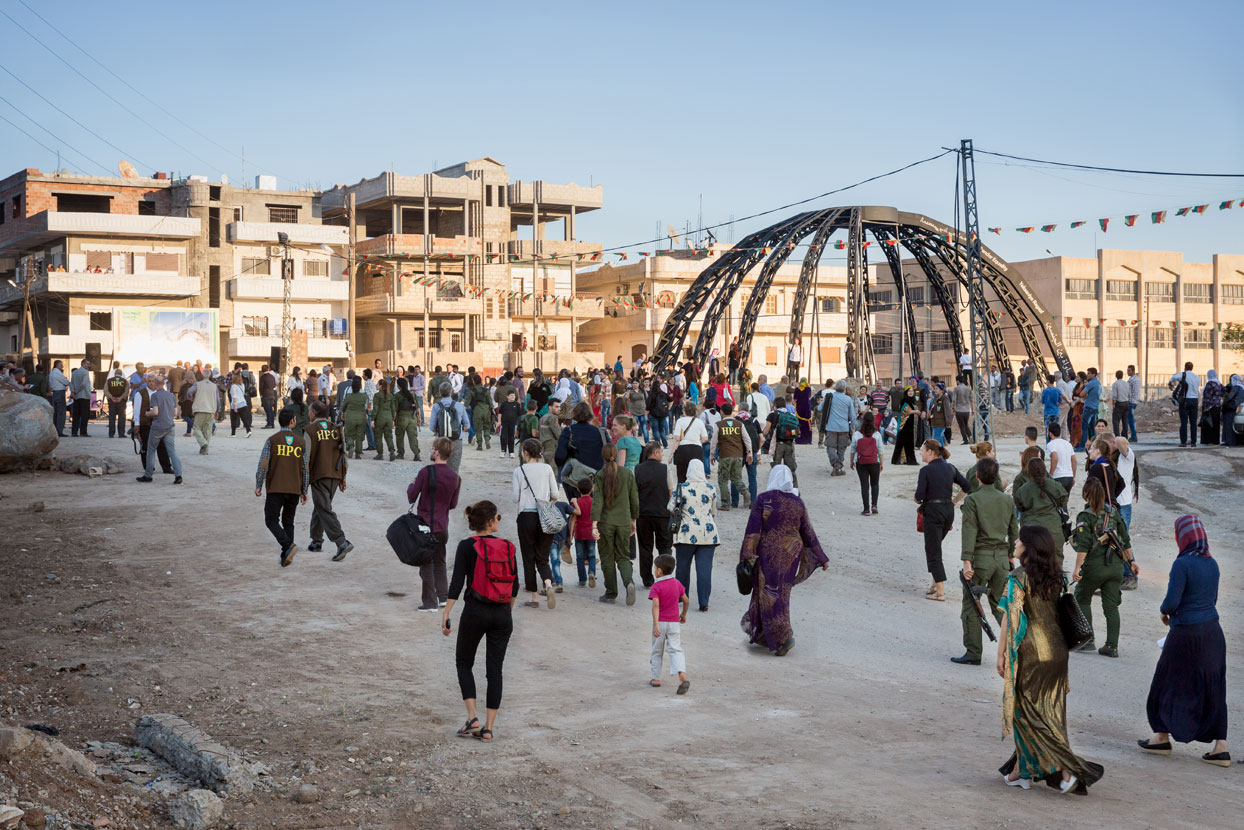
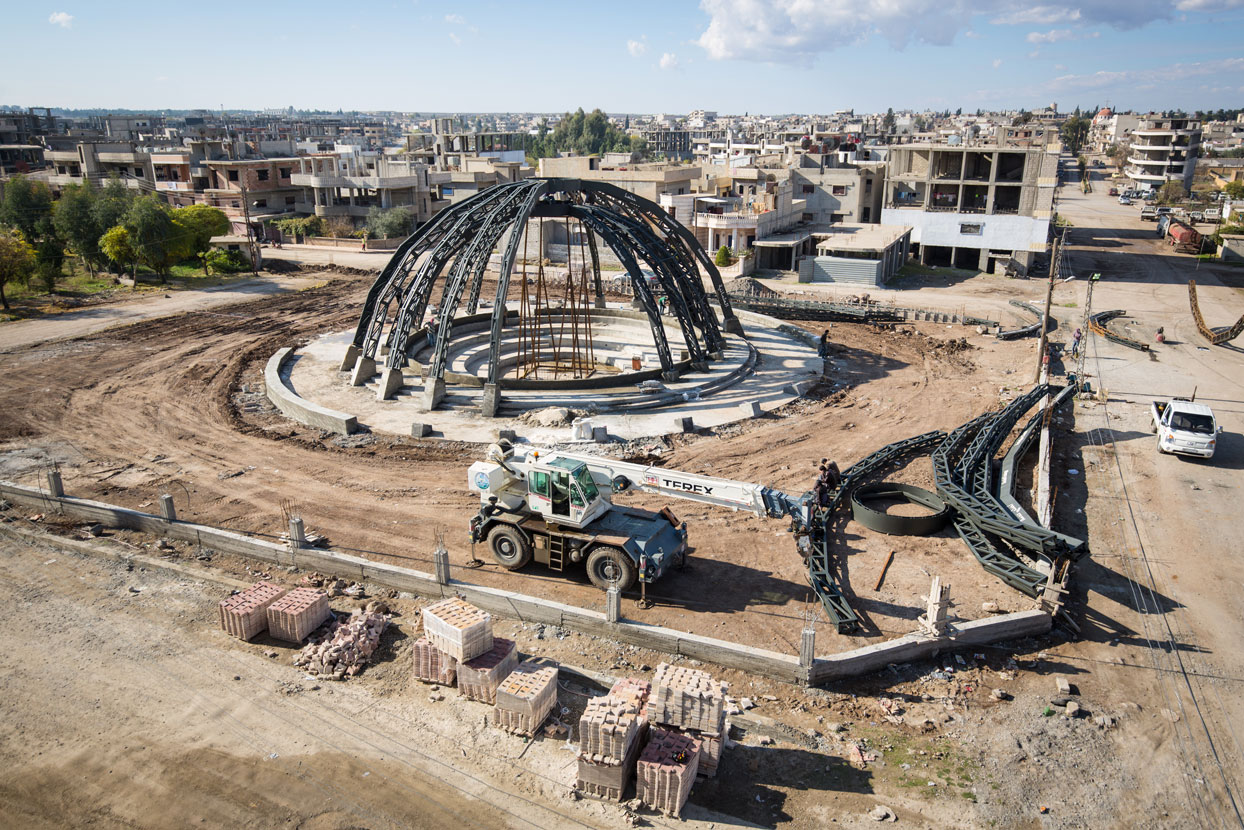
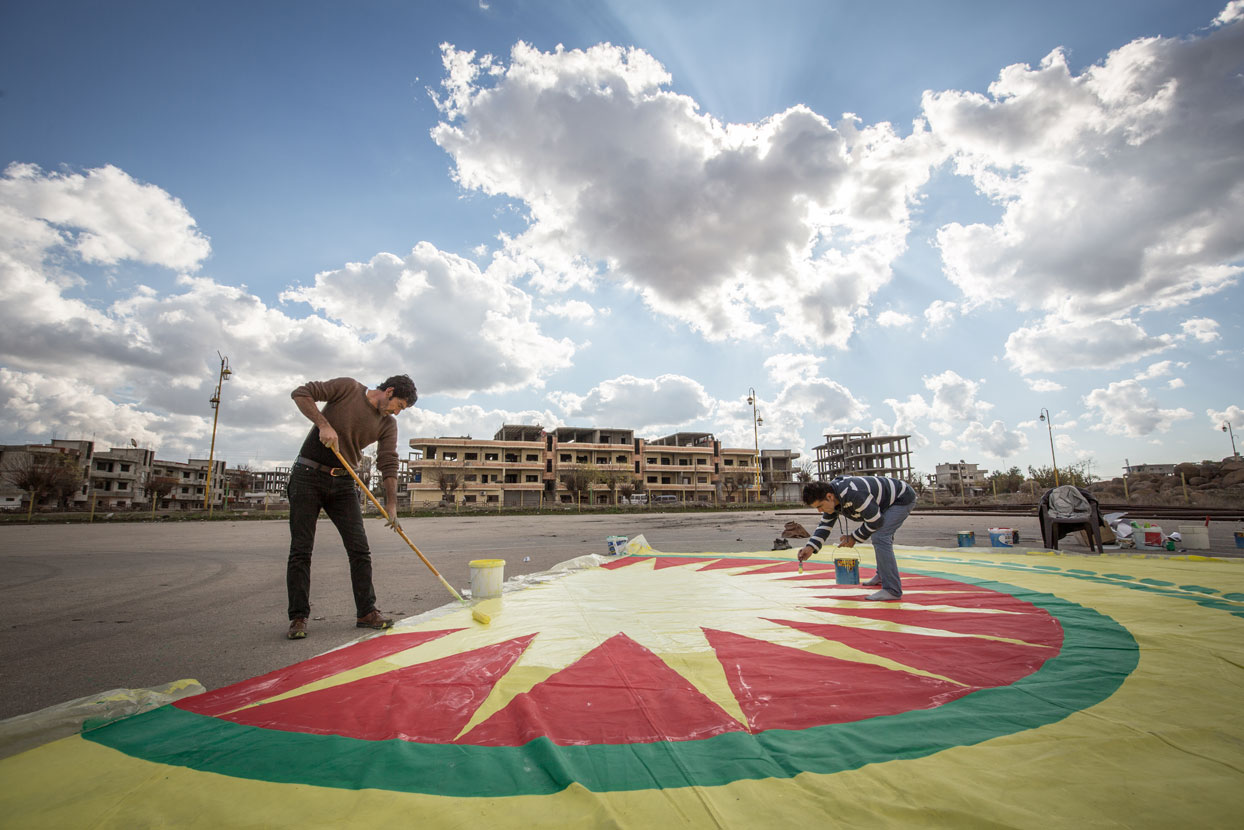
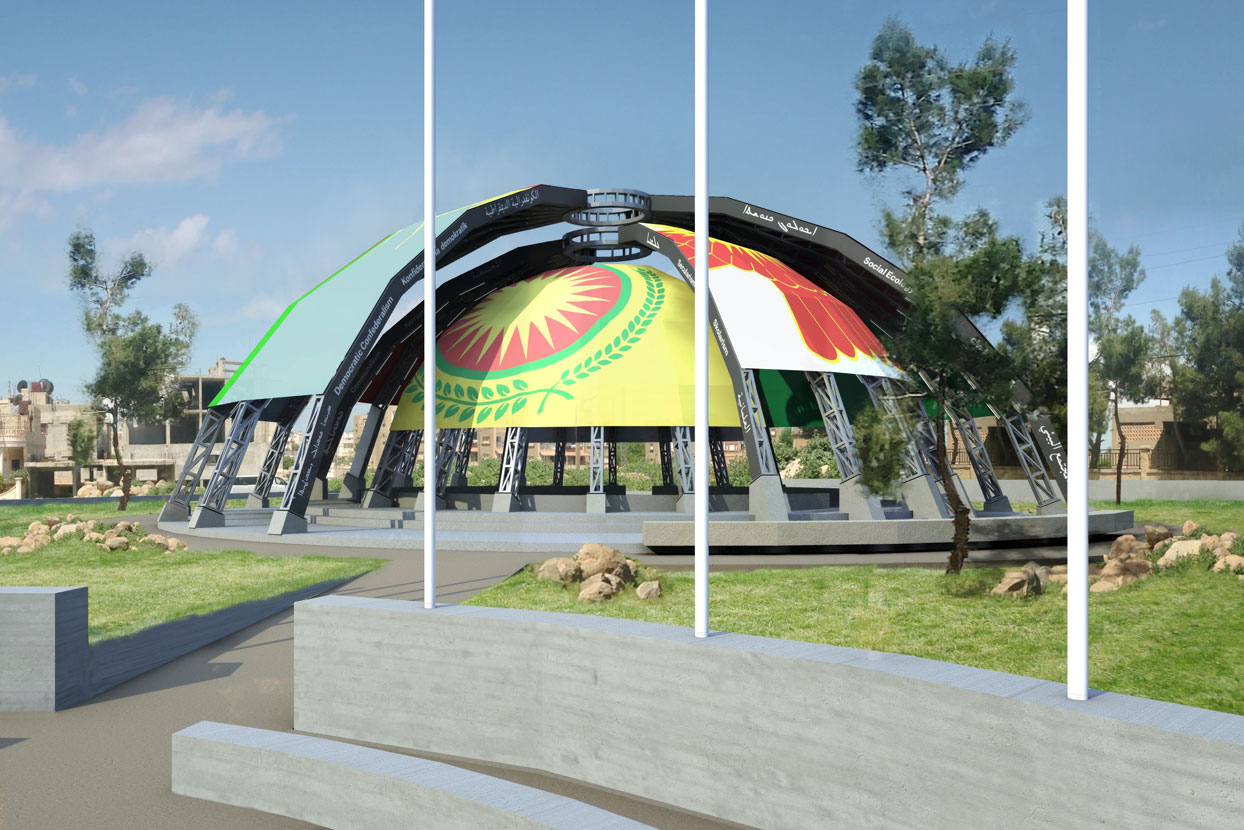
‘Welcome to Syria, the Cradle of Civilization,’ a text message service alerted us as soon as our boat crossed the border from Iraq into Syria in the middle of the river Tigris. Just ten days before, Dutch artist Jonas Staal invited me to be part of the international delegation of politicians, diplomats, academics, journalists, artists and students to participate in his New World Summit in the Cizîrê canton in Rojava, Syria. I had to look it up; I had never heard of Rojava before. In July 2012, in the heat of the civil war, the Kurds in northern Syria almost imperceptibly liberated Rojava, also known as Western Kurdistan. Bashar al-Assad was fighting on too many fronts simultaneously, and couldn’t cope with another. In January 2014 the three cantons Cizîrê, Kobanê and Afrīn claimed autonomy, at that moment housing a population of approximately 4.6 million of mostly Kurds, but also Assyrian, Yezidi, Arab, Syriac and Turkmen minorities, in an area one and a half times as large as Belgium. Inspired by the writings of Abdullah Öcalan, the imprisoned leader of the forbidden Kurdistan Workers’ Party PKK, a grass-roots democracy was installed and a constitution was written in the form of a Social Contract based upon the six pillars of self-governance, gender equality, ethnic and religious diversity, the right to self-defence and communal economy. It took me only a few minutes to decide to go along on this voyage. It is not often that you get a chance to travel to the birthplace of a new democracy in the middle of a war zone and see what an artist is trying to achieve there. Last year Staal and I had corresponded about the fluid position of the artist who moves between art, activism, politics and philosophy.1 How would Staal's art land in the context of this war zone in the Middle-East? What would Staal, whose uncompromising political interventions are carried out with an almost Calvinistic austerity, be able to realize in an unfamiliar society under construction? I did not suspect then that the Rojava Revolution that we were about to witness for a week would cause me to review my thoughts on democracy, politics and the role of culture. And to be confronted with my Western scepticism when experiencing a society where ideology seeps through every pore.
The New World Summit in Rojava would be the fifth in a series after Berlin, Leiden, Kochi and Brussels.2 Founded in 2012 by Staal, the summit is an artistic and political organization that explores the potential of the arts to transform society. The first three summits focused on the effects of the blacklisting of a number of stateless political organizations since George W. Bush’s War on Terror, providing ‘alternative parliaments’ for representatives of these groups in answer to the impotence of our democracies in applying the rule of law to all people.3 During the September 2014 summit in Brussels the stateless state became the new model of democracy, connecting representatives of blacklisted groups with delegates of autonomous regions. Amina Osse, representative of the Kurdish Democratic Unity Party (PYD) and Cizîrê’s Deputy Foreign Minister invited Staal to come to Rojava to build a permanent public parliament in the city of Derîk. Osse’s request struck a chord with Staal; he doesn't want to create new art for the world we are living in, but wants to create a new world. And in Rojava he seems to have found the place to do just that, asking in his welcoming introduction: ‘How can our civil society learn from, and contribute to the Rojava Revolution?’ Our tour had begun.
We would not be the first international delegation to visit Rojava; in December 2014 for example a group of scholars including American anthropologist and Occupy theorist David Graeber made a similar tour, and in May 2015 member of the British House of Lords, Lord Hylton, met with governors, ministers and institutions. All returned inspired by the Rojava Revolution, and called in vain for international recognition of the self-proclaimed autonomous region of Rojava, and the lifting of political and economical embargos imposed by Turkey and the Kurdistan Regional Government in Iraq. Besides these hostile parties in the north and east of the region, Rojava is threatened by the Islamic State in the south and west, while in Qamishlo, the capital of the Cizîrê canton, Assad and his troops control the only airport in the region and a number of neighbourhoods in an uncomfortable cohabitation. It is hard to imagine another region in the world where the stakes – the emergence of a grass-roots democracy in the middle of a war zone – are so high and the internal and external threats even higher.
Rojava follows the model of democratic confederalism developed by Öcalan,4 who in the nineties turned away from Marxist-Leninism and toward a more libertarian leftism after the collapse of the Soviet Union. Behind bars Öcalan read books on ‘social ecology’ by radical American social theorist and anarchist Murray Bookchin.5 Bookchin pointed out that ecological problems can only be resolved after dealing with the underlying economic, ethnic, cultural and gender issues in society. Like Bookchin, Öcalan rejects the model of the nation-state in favour of grass-roots democracy, stating that the nation-state is a product of warfare and a colony of capitalist modernity. Capitalism and the nation-state represent the dominant male in its most institutionalized form, the PKK leader explains in many of his texts,6 hence his exclamation: ‘Kill the dominant male.’ This metaphorical murder – men are just as enslaved as women – is one of the foundations of the Rojava society, where women have forty percent representation in every level of government. The communities of the three cantons are organized in local councils and city assemblies and make all decisions based upon consensus; what we would call higher levels coordinate and implement their decisions. This bottom-up political system involves all layers of society and all ethnic groups, in theory no top-down directives can be given. The overwhelming presence in every public space of Öcalan, with his bushy eyebrows and moustache, seems to belie this theory, an effect that is magnified by the total absence of advertizing billboards. Only later did I realize that behind every portrait of Apo (short for ‘Abdullah’ but also uncle), as Öcalan is lovingly called, lies the shadow of another portrait, that of the hated Assad. It was the rule to have Assad’s photo in public and private spaces; an act of defilement was usually met with torture and imprisonment.
Everyone knows the Kurdish female freedom fighters who fought the Islamic State fiercely in Kobanê, but less known in the West is that women have been active in the Turkish Kurdish liberation movement since the eighties. Female PKK activists like co-founder Sakine Cansız and activists of the Kurdish women’s movement were fighting alongside the men, and Cansız served many years in jail, leading the Kurdish movement from inside the prison.7 The unique position of women in Rojava has been grounded in ‘Jineolojî,’ a term journalist Gönül Kaya notes was coined by Öcalan in his publication The Sociology of Freedom (2003).8 Jin is the Kurdish word for woman and derives from the Kurdish term jiyan, which means life. Öcalan articulates the necessity for an alternative science liberated from sexism, a rewriting of the history of mankind into a history of womankind, in other words ‘the creation of a women’s paradigm.’ Öcalan and many in his wake refer to a mythical past in the Neolithic era, when women were supposed to have a leading position in society.9 I knew that second wave feminists in the West supported the same myth in the seventies, and wonder if this is his source. The problem is that Öcalan, who studied political science in Ankara, never refers to sources, nor uses notes. We know he was inspired by Bookchin and Nelson Mandela,10 and seems to have been influenced by thinkers like Michel Foucault, Immanuel Wallerstein, Fernand Braudel and Friedrich Nietzsche. We also know that he has been imprisoned on charges of treason and seperatism on Imralı Island in the Sea of Marmara in Turkey since 1999, often in solitary confinement. His lawyers and family are his only contact with the outside world, and are often prohibited to see him for months on end. Öcalan has limited access to information: Who selects his reading material, who decides which information to give him?
This frustrating lack of reliable sources on Rojava and its spiritual leaders may not be surprising only three years into the revolution. But it is an enormous handicap when writing about an area our ‘writers group’ of six delegates has only been allowed to travel to under guidance of the twenty-seven-year-old Minister of Culture Bêrîvan Xalid, an interpreter and an armed escort. The three-day programme was tight, besides which the situation was too dangerous to wander off by ourselves. Yet our visits to a number of cultural centres and academies and meetings with people during the three days of the guided tour and the two days of the following summit were incredibly inspiring. In three years ten academies have been installed in the canton of Cizîrê. With a yearly budget of US 80,000 the Ministry of Culture has to rely on the passion and motivation of teachers and students who transform old buildings into passable rehearsal studios, classrooms, exhibition spaces and theatres. Everyone works as a volunteer,11 there is hardly any budget for equipment or materials. Libraries that held only books in Arabic are slowly supplemented with books in Kurdish. The revival of Kurdish culture, banned for so long, is the main focus for most academies, but new songs and plays are written as well to celebrate the revolution and to support the freedom fighters.
Our first visit was to the cultural centre in Qamishlo, named after the popular Kurdish folk singer Mihemed Şêxo who was often imprisoned for his political texts. Here 200 students from age seven are introduced to the traditional Kurdish folk culture of Botan music and dancing, building on a long and rich history. Drama, however, had a more marginal and underground existence in the past because of the ban on the Kurdish language, which may explain why the theatre directors here work with the foreign Stanislavski Method, a system of dramatic training developed by the Russian actor and theoretician of the same name in the beginning of the twentieth century to introduce more realism into theatre. The playwright Mohammed Ashraf explained to us: ‘Instead of destroying we create, instead of the sounds of bombs we bring music. Inside hell we build paradise.’
Before the outbreak of the civil war in Syria, the Kurdish language was forbidden. For the first time in more than fifty years Kurdish is now part of the curriculum of schools. The Celadet Bedirxan Literature, History and Language Academy has educated more than 300 teachers since 2014, and is translating books from Arabic to Kurdish, printing them on normal printers in editions of 1000 copies, assembling books page by page. The situation is far from ideal, as the Turkish and Iraqi customs also refuse to let books from abroad enter Rojava, but no more books are burned or thrown into the river, which was the usual practice under Syrian rule. Another danger looms on the horizon though, that of censorship. Article 33, 34 and 35 of the Social Contract assure the freedom of expression and information, but each book to be published must pass through a committee. In an article of the badly translated publication that was handed out to us at the Legislative Council on the functions and powers of the Culture Body (which is the council)12 the morals of society are the criteria.13 As delegate member Janet Biehl pointed out in her blog,14 this article should either be more explicit, or removed. Nevertheless it was a memorable moment when the Minister of Culture handed us the first printed book in Rojava, the debut of the septuagenarian poet Mihemed Elî Şakir. And an equally moving moment occurred when we attended the first film screening since the beginning of the war. The recently erected film commune had chosen Charlie Chaplin’s classic film The Kid,15 the irresistible love story between an orphan and a tramp, advertised in 1921 as ‘6 Reels of Joy.’ In the improvised theatre more than a hundred children and their parents laughed their heads off watching the pranks of one of the greatest comedians. The last scene in which the tramp dreams that he is shot was edited out of the film. Members of the film commune thought this would be too traumatic for young viewers.
During our tour the most striking visual feature was the militarization of the Rojava society, which is aimed at self-defence: from the fighters of the People’s Protection Units (YPG) and Women’s Protection Units (YPJ) on rooftops, in front of public buildings and at the many checkpoints and roadblocks, to the elderly women dressed in traditional Kurdish costumes strung with Kalashnikovs and bullet belts that form the neighbourhood watch, and even on occasion toddlers and young children wearing fatigues, which is more than a fashion statement. From the pictures of martyrs in the streets, the portraits of martyrs pinned to people’s lapels or hung in plants inside buildings like ornaments in a Christmas tree and the sung laments on Ronahi TV, the only television station in Rojava, the message is clear: everyone is prepared to be sacrificed in the revolution. Even in Lebanon and the West Bank in Palestine I haven’t seen this total commitment to the battle of ideologies, in which the military struggle is only one of the means. Because of the omnipresence of women it works interestingly enough as an – intended or unintended – counterimage to the media coverage of the Islamic State on the one hand, and the fleeing Syrian refugees on the other. The people of Rojava will not be victimized; they hold their fate in their own hands. It is the epitome of Öcalan’s pillar of self-defence, but made me feel uncomfortable nonetheless.
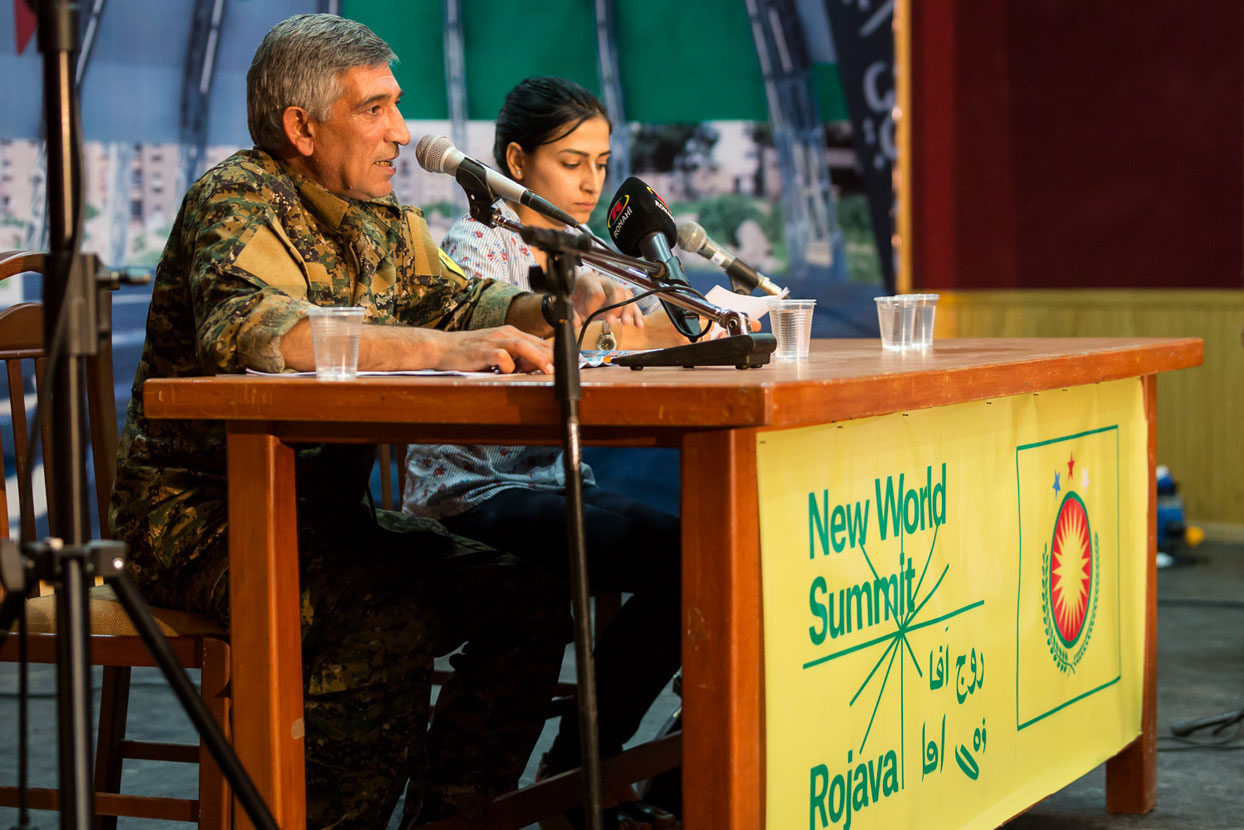
The New World Summit–Rojava Part 1 on 16–17 October 2015, was organized by Staal and his team in collaboration with the Democratic Self-Administration of Rojava. The summit brought together representatives of the Rojava administration with representatives of other stateless and progressive organizations in the world like the Catalan Popular Unity Candicacy (CUP), the women’s organization of the Filipino National Democratic Movement and the Scottish National Party, who were part of our delegation. The audience was as mixed as the inhabitants of this autonomous region: Kurdish women in colourful traditional gowns and belts, with and without headscarves, Arab men with the typical red-and-white blocked keffiyeh, men in brown baggy pants with sashes tied around the waste and flowered turbans, white-robed Yezidi women, but also men and women in suits and kids in skinny jeans and sneakers. The programme combined a speaker from abroad with a speaker from the Rojava administration, and was divided in blocks based on the main issues in the Social Contract. There were many memorable moments, but the most impressive speakers in my opinion were the commander of the YPG in the block on Self-Defence, Hussein Shawish, who started his talk with art and culture being the main weapons of self-defence, and a Yezidi woman, who gave an improvised speech about the attack on her community in Shinghal by Islamic State and liberation by the YPG and YPJ units from Rojava. The power – military and mental – of the Rojava Revolution was also confirmed by the open attitude of the majority of the speakers and the eager questions of the audience. The president of the Legislative Council Hakam Ghello encouraged the international delegates to advise the administration on how to avoid losing momentum in their grass-roots democracy.
The summit ended with a festive celebration of the partly constructed public parliament, which will be officially opened next spring. Designed by Staal in collaboration with the Dutch architect Paul Kuipers after consulting the local councils, the building will be a symbol of a new society under construction. The oval form of the parliament enables between 300–500 people to meet and talk; the half-open structure invites the outside world to enter and participate. The six pillars of the Rojava Revolution engraved in the beams are intended to remind people of the original ideas that started this new society. But more than its symbolic value, it is set to become the physical platform for the local communes, cooperatives and councils for deliberation, discussion and hopefully dissent. The celebration of Staal’s contribution to the new world of Rojava ended with a Kurmanji dance, with pinkies of the long row of dancers interlaced and the singers ululating in jubilation. In spite of the silhouettes of the many fighters on the surrounding buildings against the setting sun, it was hard not to believe in the success of this communal adventure.
On our last evening in Derîk, the women in our delegation received the request to have a final meeting with a few women of the Yekitîya Star Women’s Academy, responsible for the education and promotion of gender equality and the organization of economic autonomy of women in communes. We were tired but still euphoric after the week of guided tours, the summit and the festive opening of the parliament, but hadn’t spent a lot of time with the Jineolojîsts and agreed to meet. Again we were confronted with the effects of brainwashing: the only woman who spoke repeated Öcalan’s feministic ideology without varying her vocabulary, and with a beatific smile on her face: jineolojî would liberate us Western women from the chains of exploitation, pornography and male domination, the only thing she asked was to spread the word. After an hour I was able to escape, but with an uneasy feeling: Were we in our turn equally brainwashed by the capitalist consumerist ideology?
Do you need hell in able to create paradise? The chaos of the civil war in Syria and the power vacuum that was the result of it can keep Rojava out of the wind for as long as the war lasts. What I learned from our visit is that in this region surrounded by war, culture is seen as one of the driving forces of a democratic society, not a luxury commodity as our politicians and many people in the West think. Amina Osse’s invitation to a Dutch artist to build a public parliament in Rojava seemed bizarre at first. Nevertheless her choice for Staal was radical but extremely precise. Both Staal and Osse envision a future where art and culture are among the building blocks of a new world and their conviction is carried by many. With a passion we can only dream of, people are fighting to create a safe, multi-ethnic and multi-religious society where all are equal. The revolution could become an example for the entire Syria, Prime Minister of the canton Cizîrê Akram Hesso stated, even for the Middle-East region as a whole. Nobody can predict what will happen to Rojava the moment there is peace in Syria. In the meantime a number of us based in the Netherlands have joined efforts to establish links between academies and universities here and in Rojava, in support of a revolution that raises many questions, but may show a route to a better society.
Links for further reading
1. In connection to my article found here: www.seeyouinthehague.nl.
2. See www.newworldsummit.eu.
3. See for example Marieke de Goede, Speculative Security: The Politics of Pursuing Terrorist Monies (Minneapolis: University of Minnesota Press, 2012).
4. See for PDFs of excerpts of Öcalan’s writings in different languages www.freeocalan.org.
5. See www.biehlonbookchin.com.
6. Öcalan’s texts have primarily been made public by his lawyers during his defence in trial and appeal. During periods of (secret) peace negotiations between Öcalan and the Turkish government the PKK leader had more freedom to publish his texts.
7. Cansız was murdered in Paris on 9 January 2013 together with two other Kurdish women activists Fidan Dogan and Leyla Söylemez. Staal pointed out that Cansız’s three-volume biography has only been translated into German, which may partly explain why she is less visible than Öcalan whose writings have been published in many languages.
8. See www.kurdishquestion.com.
9. See for example Cynthia Eller, The Myth of Matriarchal Prehistory: Why an Invented Past Won’t Give Women a Future (Boston: Beacon Press, 2000). With thanks to Jennifer Knust for pointing out this title.
10. See www.new-compass.net and www.kurdishinfo.com.
11. Contrary to countries like the Netherlands, where a large part of the cultural world works on a (semi-)volunteer basis, this is not a sign of disrespect. All people in all sectors are volunteers and receive a minimum allowance. How people can survive in this system and how the economy is run, has remained totally unclear to us.
12. A set of laws that are issued by the Legislative Council in Jazire canton in 2014.
13. The article states: ‘A commission of Culture Body is formed to read the book to indicate their suitability for deployment and its compatibility with the general legal system and its suitability to the morals of society.’
14. See ‘Paradoxes of a Liberatory Ideology,’ Ecology or Catastrophe, blog, 22 November 2015, www.biehlonbookchin.com.
15. See www.kominafilmarojava.org.
Brigitte van der Sande is an art historian, independent curator and advisor in the Netherlands. In the nineties Van der Sande started a continuing research into the representation of war in art, resulting in exhibitions like Soft Target. War as a Daily, First-Hand Reality in 2005 as BAK, basis voor actuele kunst in Utrecht and War Zone Amsterdam (2007–2009), as well as many lectures, workshops and essays on the subject within the Netherlands and abroad. In 2013–2014 she curated See You in The Hague at Stroom Den Haag, and co-curated The Last Image, an online archive on the role of informal media on the public image of death for Funeral Museum Tot Zover in Amsterdam. Van der Sande is currently working on a concept for a festival of non-western science fiction, that will take place in 2016.